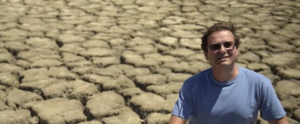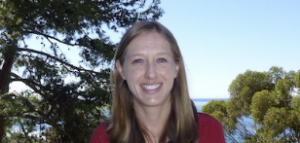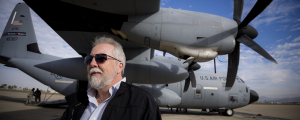Extreme Weather
Selection of Scripps Oceanography & UC San Diego research & resources
Extreme precipitation
Extreme events such as heavy precipitation have some of the biggest economic and societal impacts, even though they can last just a few days.1 Many large storms are atmospheric rivers (ARs) that carry water vapor over the ocean and upon landfall can release this vapor in the form of extreme rainfall. The Scripps Center for West Weather and Water Extremes (CW3E) is developing a weather forecast model, West-WRF, that focuses on improving the forecast of these extreme events. CW3E and other Scripps scientists participated in and are developing plans for future field campaigns that focus on observations of ARs and aerosols to support improved forecasts of ARs and other extreme precipitation events.
PIs: Marty Ralph, Julie Kalansky
Down-scaled regional weather models of precipitation and drought
On the climate time-scale, Scripps scientists have developed a new statistical downscaling method, called LOCA (Locally Constructed Analogues), that has been designed to simulate the intensity of extreme weather events with better accuracy than previous approaches. A large ensemble of the LOCA downscaled climate simulations is being used in the California Climate Assessment and in the National Climate Assessment. In addition, for the California Climate Assessment, Scripps scientists have developed an extreme multi-year drought scenario to investigate how the region may be impacted and respond to an extreme drought. These models have been implemented for California but developed for broader and regional studies across the United States.
PIs: Daniel Cayan, David Pierce, Sasha Gershunov
Increased heat wave risk
In July 2006, a devastating heat wave swept through California killing over 600 people. Epidemiologists with the California EPA were trying to understand why the event was so deadly and whether it was a statistical outlier, a meteorological fluke, or a fundamental change in heat wave activity. Scripps addressed this question by launching a new research direction to understand heat waves and their climate-scale behavior and trends. Scripps scientist Sasha Gershunov, Kristin Guirguis, and others identified anthropogenic trends in heat wave activity. Analysis of future climate projections with historical heat wave data has indicated several likely future changes in California, including 1) an increase in frequency, intensity, and duration of heat waves with a warming climate; 2) a disproportionate increase in humid heat waves that are expressed more strongly at night; and 3) an increase in extreme heat waves along the coast of California relative to other parts of the state.
PIs: Sasha Gershunov, Kristin Giurguis, Daniel Cayan, David Pierce
El Niño-Southern Oscillation (ENSO) modeling
Scripps field work in the Bay of Bengal and statistical studies have evaluated average rainfall and air-sea interactions relevant to improving predictions for ENSO and weather patterns in the Pacific. ASIRI is an international research effort including Scripps aimed at understanding and quantifying coupled atmosphere-ocean dynamics in the Bay of Bengal, which generated an unprecedented ocean and atmospheric dataset for weather simulations. These simulations with observations like sea surface temperatures in the tropical Pacific or Indian Ocean basin can be used to understand deviations between predicted and observed El Niño phenomena for improved predictions.
Scripps scientists have evaluated historical precipitation data to create a catalog of extreme rainfall along the West Coast of North America, identifying a long-term trend of increasing water vapor transport to the West Coast associated with Pacific Ocean sea surface warming. This research identified patterns to help forecast for extreme seasonal rainfall.
PIs: Shang-Ping Xie, Aneesh Subramanian, Alexander ‘Sasha’ Gershunov, Daniel Cayan, Andrew Lucas
Monitoring and predicting hurricanes
NOAA’s Global Drifter Program, which is managed by researchers at Scripps, deploys, monitors, and collects data from drifting buoys globally. The goal of the Global Drifter Program is to maintain a global array of satellite-tracked drifters and to provide valuable climate and weather data to the forecasting and research community. While satellite technology makes it possible to obtain sea surface temperature measurements from space, drifters are needed to ensure the measurements are accurate. Without drifter observations to correct satellite measurements, dust and other aerosols in the atmosphere can cause errors. There are currently over 1,000 drifters deployed. Drifters have been air deployed in the paths of hurricanes and typhoons to measure how the ocean and atmosphere interact during storm passage and to improve intensity forecasting. Air-deployable vertical profilers have also been used to collect an unprecedented amount of air-sea interaction data in hurricanes to complement drifter data. These instruments provided observations of surface and subsurface oceanic currents, temperature, salinity, gas exchange, bubble concentrations, and surface wave spectra to a depth of 200 m on a continuous basis before, during, and after storm passage, as well as surface atmospheric observations of wind speed (via acoustic hydrophone) and direction, rain rate, and pressure.
PIs: Eric Terrill, Luca Centurioni
Global ocean observations to improve extreme weather prediction
Observations from autonomous vertical profiling gliders created and deployed by Scripps improve predicative power of modeling for extreme weather phenomena derived from close ocean-atmosphere coupling. The Spray glider lab, lead by Scripps Professor Daniel Rudnick, calculates indices using glider-measured temperatures, and Scripps contributes to and leads Argo, a global array of over 3,800 free-drifting profiling floats that measures the temperature and salinity of the upper 2000 m of the ocean. The Deep Argo program extends this range to 6000 m. Much of this data is freely available and maintained at Scripps.
PIs: Daniel Rudnick, Dean Roemmich, Uwe Send, Eric Terrill, Luca Centurioni
Time series ocean observations from moored sensors
Professor Uwe Send, specializes in oceanographic research (physical oceanography and interdisciplinary problems) with timeseries observations using moored sensors. A present gap in the sustained ocean climate observing system are techniques and programs for monitoring the circulation and mass, heat, and freshwater transports of major current systems. Depending on the intensity, width, and depth extension of the current to be observed, different approaches and technologies exist now which allow implementation and maintenance of such “transport reference sites”. For broad-scale and full-depth circulations, a recently demonstrated method consists of fixed-point installations with moored and bottom-mounted instruments to obtain horizontally and vertically integrated measurements throughout the water column. The Meridional Overturning Variability Experiment (MOVE) proposes to maintain the developed elements of the first such system by taking over partial operation of a moored transport array in the Atlantic.
PIs: Uwe Send
Noted references:
1. Pierce, D and Cayan, D. High Resolution LOCA downscaled climate projection aim to better represent extreme weather events. Scripps News, Scripps Oceanography, Sept 12, 2016. Link
Work with Scripps
- Access leading climate and oceanographic expertise for decision-making and product development
- Design collaborative research that tackles risk due to extreme weather
- Get a seat at the table for the latest scientific updates
- Learn how to implement newest climate and weather models
- Work with talented Scripps students and potential new hires

Dr. Daniel Cayan, Researcher, Scripps Institution of Oceanography
Director, California Nevada Applications Program
Director, California Climate Change Center

Dr. Alexander ‘Sasha’ Gershunov, Research Meteorologist
Scripps Institution of Oceanography

Dr. Julie Kalansky, Scripps Institution of Oceanography
Operations Manager, California Nevada Applications Program,
Center for Western Weather and Water Extremes (CW3E)

Dr. F. Marty Ralph, Research Meteorologist, Scripps Institution of Oceanography
Director, Center for Western Weather and Water Extremes (CW3E)

Scripps Institution of Oceanography

Scripps Institution of Oceanography

Professor Shang-Ping Xie, Scripps Institution of Oceanography
Roger Revelle Chair in Environmental Science
